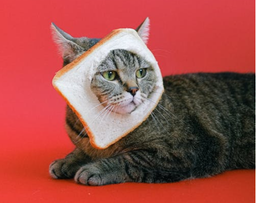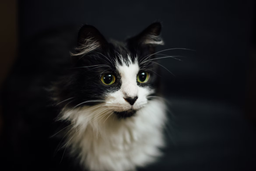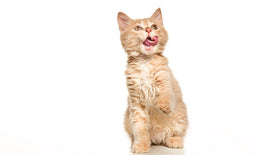Can cats eat sweet potato, and does the tater cater to their biology?
Not to be confused with regular spuds, sweet potatoes are versatile, with over six thousand different types worldwide. The starchy vegetable is exceptionally nutritious, full of moisture, fibre, and a signature sweet aroma.
Does the tasty tuber have any biological value for your carnivorous pet? Can cats eat sweet potatoes, and do they even need carbohydrates in their diet? Let’s talk about healthy eating habits in felines and find out what cats can and cannot eat.
Can cats eat sweet potatoes?
Sweet potatoes and other root tubers aren’t inherently harmful to cats but shouldn’t be part of their daily meals. The average-sized sweet potato contains around 86 calories and the following nutrient ratio:
- 77% water
- 1.6 grams of protein
- 20.1 grams of carbohydrates
- 4.2 grams of sugar
- 3 grams of fibre
While the water content is satisfactory, the high allowances of sugar and carbs could pose a problem. Felines cannot harness carbohydrates for nutritional purposes and can only handle moderate amounts (below 3%).
The enzyme activity required for glucose regulation is extremely low in felines. If cats binge-eat sugary foods like sweet potatoes, cereals, rice, bread, and other starches, they’re more likely to suffer from:
- Gastrointestinal problems
- Obesity
- Diabetes
- Liver disease
What’s the best way to prepare sweet potatoes for your cat?

Can you share your sweet potato casserole with your feline friend?
Source: Louis Hansel
If you want your cat to try sweet potatoes, your best bet is to gently steam the vegetable in unseasoned water. Here’s a rundown of the cooking process:
- Fill a large pot with water, and don’t add salt, herbs, or any seasoning
- Peel the sweet potatoes and cut them into two-inch pieces
- Bring the water to a boil and add the chunks
- Lower the heat to medium-high and cook the veggie for 20–25 minutes
- Drain the sweet potatoes and leave them to cool
But wait, can cats eat sweet potatoes without cooking? Unlike spuds and other nightshades (e.g. tomatoes and eggplants), sweet potatoes don’t produce solanine—a chemical with pesticidal properties. Raw tubers are cat-safe, but there are certain risks involved.
Fresh produce can sometimes contain insecticides and other highly-toxic pest control products. Boiling sweet potatoes will remove any chemical residue, so it’s the safest preparation method.
How often should cats eat fruits and veggies?
Despite their limited ability to process carbs, cats can enjoy fruits and veggies in moderation. Your pet can have sugary treats once or twice per week, as long as they eat regular meat-based meals. Snacks should be kept below 10% of the diet because they could cause a calorie surplus.
According to some experts, tiny amounts of high-fibre fruits and veggies can soothe acute digestive problems. The dietary fibres may help with constipation and alleviate inflammatory bowel disease symptoms. If your cat suffers from stomach problems frequently, you can give them a bite of the following fruits and veggies:
|
Fruit or vegetable |
Fibre content per 100 g |
Sugar content per 100 g |
|
2.4 g |
1 g |
|
|
2 g |
1.7 g |
|
|
2.8 g |
4.7 g |
|
|
2.7 g |
2.8 g |
|
|
2 g |
4.9 g |
|
|
2.4 g |
10 g |
|
|
2.4 g |
10 g |
|
|
2.6 g |
12 g |
Keep in mind that too much soluble fibre in your cat’s meals can result in chronic dehydration. The nutrient absorbs moisture from the feline’s body passing through the digestive system.
What should your kitty eat for the main course?

I’m a meat-lover at heart!
Source: @lavivador_cats_family_
All cats are obligate carnivores, so an entirely vegetarian diet would take a toll on their health. Your furry friend requires regular meat-based meals with:
- Moisture—Your cat needs hydrating meals since moisture helps with blood circulation and nutrient absorption. Insufficient water intake can damage your cat’s digestive, reproductive, and urinary system
- Protein—Plant-based protein can’t meet the feline’s energetic and nutritional requirements. Only protein sourced from animal tissue (poultry and fish) can enable:
- Tissue formation
- Muscle development
- Vital organ function
- Taurine synthesis
- Polyunsaturated fats—Unlike saturated fats in some foods (e.g. pork, deli meat, avocados, coconut oil, etc.), the fatty acids in fish are good for your cat. The omega-3 and omega-6 keep their skin and coat healthy while aiding wound regeneration
- Bioavailable vitamins and minerals—Cats need these micronutrients in their diet to sustain proper enzyme function and cell structure. Ideally, they should harness bioavailable vitamins and minerals from their food and not via supplementation
Which type of food is closest to your cat’s natural diet?
Dry food often contains carbs, like green peas, corn, sweet potatoes, or potato starch, which increase the calorie content of the final products. Although ground meat is the key ingredient in kibble, the added fillers reduce its nutritional properties.
On top of the high-calorie percentage, cat biscuits only have 10% water, which isn’t particularly hydrating. An entirely dry-food diet could lead to several health issues in felines, such as obesity, diabetes, severe dehydration, and feline lower urinary tract disease (FLUTD).
If your cat loves their biscuits, it’s best to mix them with their daily servings of wet food. Wet products have a much better nutrient ratio, high moisture content, and more than 50% protein. High-quality wet food is also free from grain fillers and sugar.
An average-sized fully grown cat should have at least two wet meals per day. If your pet is being finicky about their luncheon, the good news is you can switch between various textures. Wet food is quite versatile, so you can get pates, purees, gravy, and jelly!
Looking for a low-carb, feline superfood? Get Untamed!

Oh my, is all this for me?
Image (c) Untamed
With Untamed, your cat can enjoy well-balanced meals every day! Our vet-formulated recipes are made with high-quality ingredients with optimal bioavailability. We don’t use vegetable protein or grain fillers in our products!
Untamed feline delicacies are gently steamed to ensure each serving is:
- High in protein—Our meals deliver twice the amount of animal protein than other commercially available cat food. Your kitty will get all the taurine they need to thrive
- Made with whole meat—We use natural, fresh ingredients and human-grade meat cuts in our wide assortment of seafood and poultry dishes made with high-quality:
- Chicken breast
- Chicken liver
- Lean ham
- Duck breast
- Salmon fillet
- Tuna steak
- Sardine and mackerel fillet
- Shrimp
- Impossible to resist—Even if your pet is a fussy eater, our food can kickstart their appetite! The enticing aroma of our feline delicacies is irresistible to kittens, adult cats, and oldtimers
Since Untamed food is designed to mirror your cat’s natural feeding pattern, it comes with a slew of health benefits! Long-term clients have noticed several significant improvements in their cats. Here’s what you can expect from the Untamed effect:
|
Timeline |
The Untamed effect |
|
Week one |
|
|
After two months |
|
|
Within four months |
|
|
For life |
|
Design a personalised meal plan for your cat!
Would you like to create a menu for your pet based on their life stage, food sensitivities, and preferences? Fill out an online questionnaire on our TRY NOW page and choose from various jelly and gravy recipes described in the table below:
|
Our menu |
Details |
|
Chocka Chicken in Jelly* |
High-quality chicken breast dipped in natural jelly |
|
Chocka Chicken with Duck in Jelly |
Fresh chicken and mouth-watering duck meat, served in jelly |
|
Chocka Chicken with Ham in Gravy |
Gently cooked chicken breast and delicious ham in natural chicken gravy |
|
Chocka Chicken in Gravy* |
Shredded chicken simmered in rich natural gravy |
|
Tuck-in Tuna in Jelly* |
Dolphin-safe tuna steak in appetising fish broth |
|
Tuck-in Tuna with Salmon in Jelly |
Tuna steak in jelly with high-quality salmon fillet to boost the flavour |
|
Tuck-in Tuna with Shrimp in Jelly |
Irresistible tuna served with shrimp in jelly |
*Chocka Chicken in Jelly and Tuck-in Tuna in Jelly are Untamed’s single-source-protein recipes, perfect for allergy-prone cats!

Treat your cat to our delicious protein-packed meals—no starches, no sugar, no grain!
Image (c) Untamed
How to get Untamed in a few easy steps
If you’d like to prepare a healthy and delicious feast for your furry friend, follow these simple steps:
- Visit our TRY NOW page
- Tell us about your cat
- Make a personalised meal plan
- Place your order
Your first customised cat food meal box will arrive safely at your doorstep within a day, with no additional shipping fees. If your feline companion is happy with the selection, you can get monthly supplies of Untamed food. You are 100% in charge—modify or cancel your cat food subscription at your convenience.
Are any fruits and veggies toxic to cats?

Wha-what do you mean I can’t eat something? You’d say no to this face?
Source: @rosie_torbie_cat
Some fruits and veggies contain chemical compounds that can affect your cat's bodily functions. Keep the following out of your kitty’s reach:
- Grapes and raisins aren’t pet-friendly for reasons yet to be discovered. Nutritionists are currently researching what makes the fruit harmful to cats and dogs. Some likely causes for the toxicosis include mycotoxins (also found in nuts, cereals, and coffee beans), tartaric acid, and tannins. Cats can experience several health issues after eating grapes, including vomiting and diarrhoea, followed by lethargy, appetite loss, or acute kidney disease
- Cats can experience intense gastrointestinal discomfort after eating citruses. The essential oils and citric acid in the flesh and rinds are extremely irritable to felines. Your pet can develop contact dermatitis, so make sure to store your lemons and limes safely. Citruses can also cause photosensitivity in mammals
- Allium vegetables can induce Heinz Body anaemia in cats. Garlic, onions, and chives contain oxidants that affect the feline’s red blood cells, causing them to disintegrate at a much faster rate than normal. If you like making homemade meals for your kitty, including soup or broth, don’t use any garlic powder since it’s also harmful. Besides allium veggies, kale and turnips have a similar effect on felines
Check out our other guides to what cats can or cannot eat:
|
|

![Best food for Ragdoll cats in the UK [Broken Down]](http://untamed.com/cdn/shop/articles/featured_best_food_for_ragdoll_cats_uk.jpg?v=1646818249&width=256)

